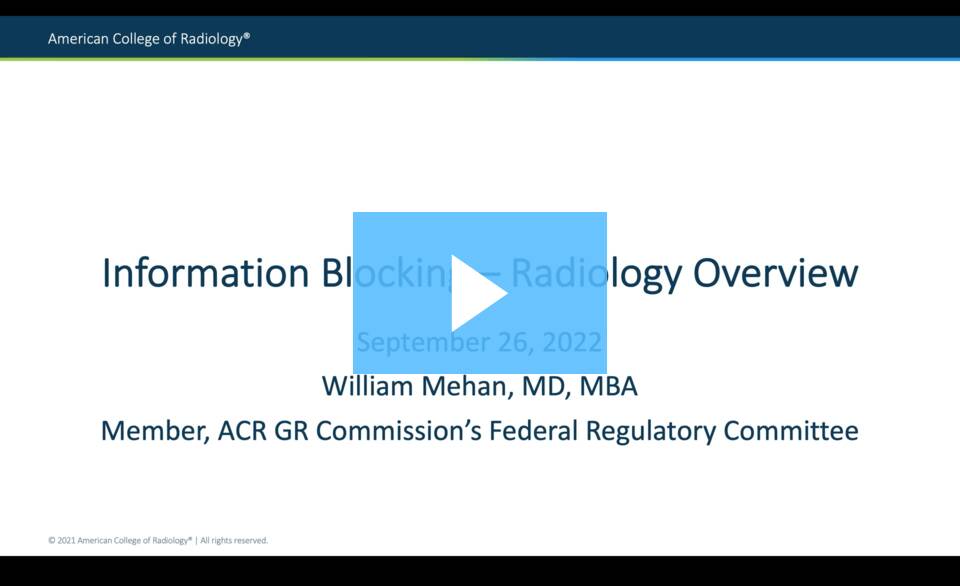The American College of Radiology provides the following only as general information. Readers should not construe this educational resource to provide specific legal advice on their individual practice matters. This information is subject to change depending on future rules and/or clarifications.
Background
Section 4004 of the 21st Century Cures Act (2016) expanded the authority of the U.S. Department of Health and Human Services (HHS) to investigate and penalize information blocking practices that impede legally permissible requests for certain health care data. The information blocking provision is relevant to three types of actors —providers, developers of certified health information technology, and health information networks/exchanges. Information blocking by a provider means that provider knows a given practice is unreasonable and likely to interfere with, prevent, or materially discourage access, exchange, or use of electronic health information (EHI).
The EHI definition was temporarily limited to a basic dataset from April 5, 2022, through Oct. 5, 2022. On Oct. 6, 2022, the EHI definition effectively expanded to include nearly all electronic protected health information (ePHI) that is part of the Health Insurance Portability and Accountability Act (HIPAA)-designated record set (DRS), with certain limitations. The current EHI definition is generally inclusive of most radiology data or other data used by radiologists and/or referring physicians for medical decision-making. It is not limited to radiology reports.
Providers and other actors that engage in practices implicating the provision can be reported to HHS and investigated on a case-by-case basis. If a given practice is found to be in violation, the provider is then subject to disincentives. Provider-specific disincentives were established in 2024 and include implications for the Merit-based Incentive Payment System, Medicare Shared Savings Program, and the Medicare Promoting Interoperability Program. Data about the violation will be publicly accessible online.
HHS defined eight exceptions and corresponding criteria as a voluntary method of compliance certainty for practices deemed reasonable and necessary that could otherwise implicate the provision. When an actor’s practice meets the condition(s) of an exception, it will generally not be considered information blocking.
Timeline
Information Blocking regulations were effective beginning April 5, 2021. The EHI definition expanded on Oct. 6, 2022.
Radiology Implications
When enacted in 2016, Congress intended the information blocking provision to discourage anticompetitive, anti-exchange behaviors. If well-implemented, the provision should help advance data-sharing and interoperability, including in ways that help radiology providers connect with referring providers and networks. For example, radiology providers can report other actors for unresponsiveness to requests, unfair exchange policies, or unreasonable fees that interfere with legally permissible access, exchange, or use of EHI.
Radiology providers must comply by not engaging in information blocking practices. It is generally advisable for all actors, including radiology providers, to work closely with qualified legal teams on regulatory compliance strategies that correspond with their technological capabilities. It is important to understand what data is generated or accessed by the radiology practice that would meet the EHI definition, and to factor this into all technology-related decision-making.
Radiology Resources
- Frequently Asked Questions – The ACR has received numerous information blocking-related questions. Many of these questions are difficult to address without further clarity from HHS; however, this document compiles our understanding.
- ACR Bulletin “Dispatches” Article – This July 2022 ACR Bulletin “Dispatches” article (see page 5) discusses HHS’ Feb. 2022 flexibilities for enabling patient access while avoiding surprise, as well as the Oct. 6, 2022 changes to the “EHI” definition.
- RadiologyInfo.org – Radiology information for patients and families, including suggestions for understanding accessed radiology data.
Government Resources
It is generally recommended that actors use first-party information provided by relevant HHS agencies due to the continually evolving state of implementation and enforcement.
- HHS information blocking resources – This government website provides guidance documents, answers to frequently asked questions, rules, and other links.
- 21st Century Cures Act – The “Cures Act” was a legislative package in 2016 that addressed numerous healthcare policy topics, including establishing the information blocking provision (Sec. 4004).
